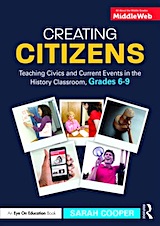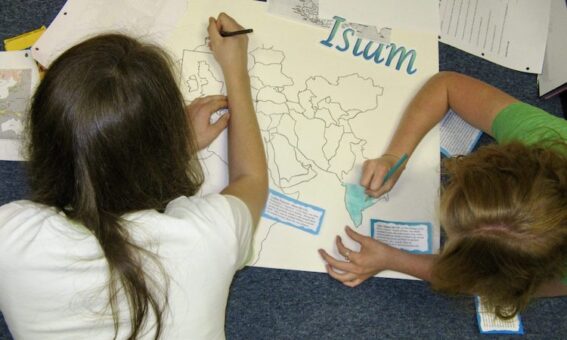5 Things I’ll Remember When I Feel Unmotivated
Like many teachers during last year’s “post-Covid” return to school, middle school veteran Sarah Cooper slipped into the fog and funk and wondered if teaching’s joy was gone for good. Here’s how she found her way back.
By Sarah Cooper

For me to keep my sanity as a teacher, this could not continue. If I lost my zest for teaching, I would be reckoning with losing a big part of my sense of self.
Slowly, over December and into January, with deliberate steps each day, I recovered my joy. I remembered that lesson planning didn’t have to feel like a slog and that the minutes could fly by in class if I got swept into the flow with my students.
So how did I wrench myself through this transition? Gradually, sometimes haltingly, remembering some of these mantras – which I hadn’t forgotten but found hard to implement that first semester.
1. Connect individually each day with each kid, even briefly.
After doing a survey where I realized a handful of kids weren’t feeling my commitment to knowing who they were and how they were learning, I turned up the volume on my connection.
Generally I say hi by name to each 8th grader as they come in, and often goodbye as they leave, but I added more smiles and checked in with individual kids about how they were doing – even about something silly like what they were looking forward to eating at lunch.
I also remembered to share what was happening with me, just a little bit – what was giving me energy or what was on my mind.
2. Laugh together.
The one element I’ve kept from Zoom teaching is a daily pair-and-share chat. This usually takes the form of a simple question, such as what students are excited or not excited about for the weekend.
As I was trying to come back to myself, I spiced up these prompts, even when I didn’t feel like being lighthearted, and the answers ended up boosting my mood.
Some questions that ignited students’ brains in a different way included: “What temperature would you be today if you were an oven, 0 to 500 degrees, and why?” and “Which animal do you feel like today?” and “What has gone better than expected for you this week, even something super small?”
3. Embrace the mess.
Recently I’ve been teaching in a new room that has nice light and space but doesn’t always feel the coziest. Last year I started with two-person tables in rows because this seemed the most logical way to arrange the furniture. One day in December, though, we moved the tables into a big rectangle for current events discussions. The kids loved it because they could look at each other more, and a quick survey said they felt more of a sense of connection. I never moved the desks back.
Was it noisier? Yes. Did we lose a couple minutes of “productive” class time each day because of this new configuration? Likely yes. Did I feel more connected because I could walk around the outside or the inside of the square? Absolutely.
And, when we were working on a project, I encouraged the kids to sprawl around the room. This is what I missed during Covid – that middle school sprawl that still facilitates learning and creates a buzz.
4. Never underestimate middle schoolers.
This principle is so basic for me. I’ve spent my whole career, it feels, telling people how much these tweens and young adolescents are capable of. So what happened? Did I forget? Did post-pandemic gaps in writing and reading skills trip me up?
I don’t know. But as students worked on projects during second semester, I remembered how much they understand, how many strengths they have, and how much they can teach me (even something small like clicking at the top right of my browser to find which tab is playing video or audio).
For one research project I gave a slew of written directions – on finding and taking notes on reputable sources – that I thought would overwhelm the kids. The research was hard work, especially for some of the students who approach learning in unconventional ways. But I was so overcome by their dedication at the end of one class that I said, “I’m so proud of you.”
5. Find a way to love your students.
Two years ago I wrote a piece for EdWeek about advice I would give to new middle school teachers. But last year, I almost forgot it myself.
I had more students than usual who came into class a little off the wall – quirky, unusual, figuring out the world in their own distinctive and wonderful ways. And yet I realized as I worked to connect more: I wasn’t seeing them. I wasn’t looking enough for all the ways to love each one of them. To appreciate how one kid doodled video game characters every day while still paying total attention to what’s going on – and another raised their hand anytime they perceived an injustice, whether current or historical – and another approached every history research topic as if it were a Big Data analysis.
And the things I love about all of them: how they cluster before the bell, and spread out during class, and lean into and out of each other as they talk and wonder and grapple. Ultimately, really, how I was lucky enough to be in the room with them as they’re growing up.
Giving yourself love and grace
In Gholdy Muhammad’s soul-affirming book Unearthing Joy: A Guide to Culturally and Historically Responsive Teaching and Learning (Scholastic, 2023), she emphasizes a similar message: “This work starts with love – loving yourself, being yourself, being kind and gentle with yourself, and showing yourself grace as you carry out this work.”
What was missing for me at the beginning of last year was not just demonstrating love toward my students but accepting my missteps as I tried to do so. What’s different now is that I’m trying to show myself more grace in the trying.

































Beautifully written, Sarah. You made me miss being a middle school teacher! Thanks for the reminder that we all need to take deliberate steps to maintain our optimism.
Debbie, it means a lot that this column inspired you to want to be with students! Thank you for this kind comment.
Love this post, Sarah. Makes me motivated for the new school year.
Lauren, back at you and nice catching up about history teaching last week! :)